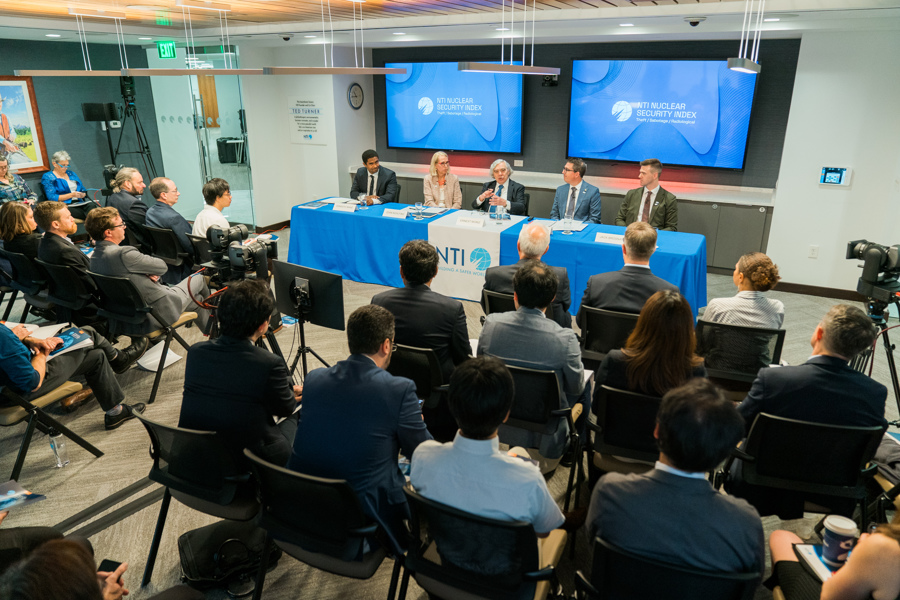Nunn, Experts Urge G8 Summit Action on WMD Security; NTI Releases Two New Reports
With terrorists actively seeking nuclear weapons, urgent measures are needed to prevent a nuclear 9/11, according to two new reports released before the G8 summit.
Report Cites Dangerous Gap in Efforts to Thwart Nuclear Terrorism; Calls for Urgent Global Campaign to Reduce the Risk
WASHINGTON – New steps are urgently needed to broaden and accelerate work to keep nuclear weapons and the materials needed to make them out of terrorist hands, according to Securing the Bomb, 2007, a report released today.
“With al-Qaeda’s central command reconstituting in the mountains of Pakistan, we urgently need a stepped-up global campaign to secure every nuclear weapon and every significant cache of potential nuclear bomb material worldwide to stringent standards,” said Dr. Matthew Bunn of Harvard University’s Managing the Atom Project, the report’s author. “We need to make sure these stocks are locked down before thieves and terrorists can get to them – and that they stay that way for the long haul.”
The new report, commissioned by the Nuclear Threat Initiative (NTI), provides a comprehensive assessment of efforts to secure and remove vulnerable nuclear stockpiles around the world, and a detailed action plan for reducing the risk of nuclear terrorism.
Even with increasing strains in U.S.-Russia relations, the two countries have made important progress in securing nuclear weapons and materials, the report concludes.
“Thanks to the good and sometimes heroic efforts of men and women around the world who are working every day to keep nuclear weapons and materials secure, we have made significant progress,” said former Senator Sam Nunn, NTI’s Co-Chairman. “But we are still not moving as quickly as we can or we must. Those in the field doing the hard work in security and safety – whether from Russia or America or other countries – need and deserve for their leaders to knock down all the obstacles that impede their progress. Preventing nuclear terrorism must be a front-burner issue for leaders at the highest level of governments around the world every day. And so far it is not.”
The Threats
The new study describes troubling indications that the threat of nuclear theft and terrorism remains high in many parts of the world. In Russia in 2006, a senior general who was the deputy chairman of the group charged with law and order in Russia’s closed nuclear cities was fired – for organizing smuggling in and out of those cities. In Pakistan, serving military officers cooperated with al Qaeda in two plots to assassinate President Musharraf – raising questions about the reliability of the military officers who guard Pakistan’s nuclear stockpile. Some 140 research reactors around the world still use highly enriched uranium (HEU) as their fuel — some with no more security than a night watchman and a chain-link fence. The seizure of nearly 80 grams of stolen 89-percent HEU in Georgia in early 2006 adds to the growing list of cases of theft of potential nuclear bomb materials.
Progress and Gaps
Most of the US government’s work to secure nuclear weapons and material has been focused in Russia and the former Soviet Union, though these efforts are now expanding worldwide.
The Recommendations
Closing the nuclear security gap will requires sustained global leadership to overcome the obstacles to securing, removing, and reducing nuclear stockpiles. The report outlines key steps to convince world leaders and nuclear managers of the urgency of the threat and the need for action. Specific recommendations include:
Sustained leadership from Washington, the report concludes, could reduce the threat dramatically by the end of the next presidential term. “Every presidential candidate,” writes Bunn, “should be asked a central question: What is your plan to prevent terrorists from incinerating the heart of a U.S. city with a nuclear bomb?”
The report and its online companion at www.nti.org/about/projects/Securing-bomb/ is the only available source for “one-stop shopping” on all aspects of these critical U.S. security programs. Since NTI first commissioned this annual report from the Managing the Atom Project in 2002, the report and its recommendations have increased public awareness of the nuclear terrorism threat and helped spur increased government action to reduce nuclear dangers.
The Managing the Atom Project, based at the Belfer Center for Science and International Affairs at Harvard’s John F. Kennedy School of Government, is Harvard’s principal research group focusing on nuclear weapons and nuclear energy policies. NTI is a Washington-based non-profit organization, focused on reducing the threats from nuclear, biological and chemical weapons and materials.
###
Sign up for our newsletter to get the latest on nuclear and biological threats.
With terrorists actively seeking nuclear weapons, urgent measures are needed to prevent a nuclear 9/11, according to two new reports released before the G8 summit.
“The bottom line is that the countries and areas with the greatest responsibility for protecting the world from a catastrophic act of nuclear terrorism are derelict in their duty,” the 2023 NTI Index reports.
NTI welcomes the G-7 leaders’ statement as they meet in the city where a nuclear weapon was used in war 78 years ago.

